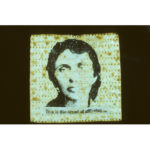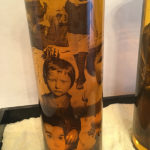Marleene Rubenstein
Marleene Rubenstein is a painter, sculptor and installation artist who lives and works in Los Angeles. Her work across media is characterized by the evidence of a slow, ritualized process and the use of materials that are carefully chosen for their psychological and emotional impact. She has a BS in occupational therapy and an MPA in public health care planning. In 1999 she earned her MFA from CSULB, winning both the university wide research writing award in the Humanities Division, as well as the prestigious Marilyn Werby Memorial award of $2500, for her thesis show.
Her work has been shown nationally in various galleries and universities, and in 2017 she participated in the Jerusalem Biennale in Israel.
Artist Statement
Throughout the centuries of our history; despite our dispersions across the continents and disparate cultures, there has been one consistent source of nourishment for the Jewish people – the Torah.
On the Jewish festival of Simchas Torah it is customary to dance joyously with the Torah to celebrate the fervent joy in fulfilling its commandments and to celebrate the cycle of its reading. The last portion of its weekly readings is finished, and begun again on the same day to signify there is no real ending, it is a cycle of perpetuity. It happened once in the Warsaw Ghetto on one Simchas Torah, there were no scrolls left. They had all been destroyed. The war was raging, the ghetto numbers dwindling from disease, starvation and deportations. How then were the celebrants to properly express their jubilation in the Torah and its commandments? What would symbolize the proper depth of their honor and joy? They grabbed up their surviving children and danced with them. The children would become their Torah scrolls,
Milk and Honey is a mixed media sculpture that incorporates the concepts of physical and spiritual sustenance. Two glass vitrines are filled with honey and placed on a serving tray that has been covered with milk powder. Topped with wooden caps and finials they resemble a Torah scroll. But instead of words, mine hold the images of Jewish children photographed in Europe just before the outbreak of WWII. Covered with sweetness, sitting on milk, their first sustenance, they have been reborn as Torah scrolls, like those used in the Ghetto.
The Torah was given to the Jewish nation to sustain and guide them as a people. It has been likened to milk and honey in various Jewish sources; and just as it has over the past millennia, so will it continue to nourish the future generations that survive as Jews.
Retelling
It was rare for the Bergman family of Stoczyk to take a family portrait, and rarer still to send it to America. Raizel Devorah, the Chassidic mother of eight, sits between her son Zisha and his wife Rivka. She holds her grandson Shmuel who tightly clutches his favorite ball, while Rivka cuddles Basha who holds a doll. Standing behind them is 16 year old Mechele, her hair carefully curled for this special occasion. Raizel looks pensive almost as if she could see into the future. It is 1939. Soon, everyone in that photo would be dead – murdered in Treblinka.
From that huge extended chassidic family of 37, there would be only one survivor, my husband’s mother Chava. In keeping with Jewish tradition, she would name him for her two murdered brothers. Two of our daughters are named for the family in that photo. The Bergmans became my family as well, for we are linked by blood. My grandchildren continue the legacy…
“Retelling” is what we do on Pesach as around the world, we Jews recite the Haggadah, retelling the story of our slavery and of our freedom. It is a holiday of signal contrasts; the flat bread of slavery contrasted with the feast of freedom , bitter herbs contrasted with joyous cups of wine, and the joyous faces of family and friends contrasted with the ghosts of those who came before.



